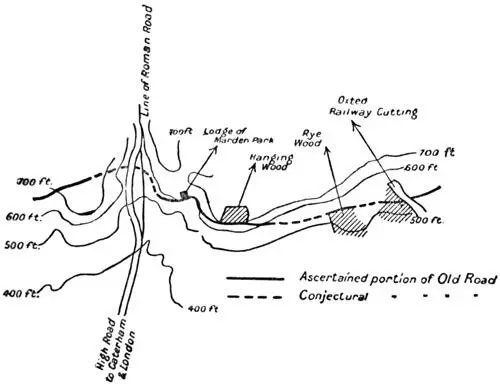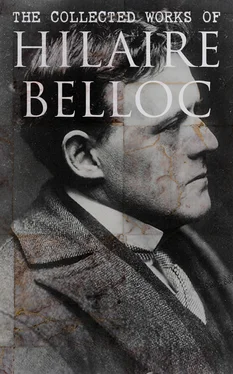When one considers the condition of the terrain immediately to the east, the loss is not to be marvelled at. The hillside of Upwood Scrubbs falls very steeply into the valley by which the modern high-road climbs up to Caterham. It is an incline down which not even a primitive road would have attempted to go, and when one gets to the valley below the whole place is so cut up with the modern road, the old Roman road a little way to the east, and the remnants of a quarry just beyond, that it would have been impossible in this half-mile for the trace of the Pilgrim's Way to be properly preserved. I will, however, make this suggestion: that it descended the hillside diagonally going due NE. from the summit to the old gravel pit at the bottom, that then it curved round under the steep bank which supports Woodlands House, that is Dialbank Wood, went north of Quarry Cottage, and so reached the face of the hill again where the lane is struck which skirts round the southern edge of Marden Park. This, I say, will probably be found to be the exact track; but it is quite certain that the Way cannot have run more than a couple of hundred yards away from this curve. It cannot have been cut straight across the valley, for the steepness of the valley-side forbids that, and, on the other hand, there would have been no object in going much further up the valley than was necessary in order to save the steep descent.
At any rate, the gap is quite short and the road is easily recovered after the combe and the high-road are passed; it is thence identical with the lane I have spoken of above. This lane is called Flower Lane. It follows the 600-feet contour-line and winds therefore exactly round the outline of the hill. It passes the lodge of Marden Park, and within a few hundred yards comes to a place where the modern road bifurcates. The good macadamised lane goes straight on and somewhat downwards towards the plain. Another, less carefully made, begins to wind up the hill above one. From this point onward the Old Road takes again to the rough ground.

There lies just before one on the hillside a wood, called 'The Hanging Wood.'
We skirted the south edge of this wood and found beyond it a field in which the track is lost; 31nor was the task of recovering it an easy one, for the light was just failing, and here, as always where cultivation has risen above the old level, the Old Road is confused and destroyed.
We had, however, over these few yards an excellent clue. In a wood called 'The Rye Wood' just in front of us the track of the Old Road is not only clearly marked, but has been preserved by local traditions. For this NW. corner of the Rye Wood we made, through the south of the spinney called 'Hogtrough Spinney.'
Just beyond the Rye Wood, the hillside is pierced by a deep railway cutting which is the entrance to Oxted Tunnel. This cutting comes right across the line of the Old Road. We made for this point (which is a few yards north of the first bridge), but when we reached it, it was quite dark, and if we had covered in that day but eighteen miles or so, it must be remembered how much of our time had been spent in the perpetual checks of this division. 32
We reluctantly determined, then, to abandon the hillside for that evening, and to go down to the plain and sleep. The nearest place of hospitality was Oxted. We made for that village in the darkness, stumbling along the railway-line, and in the inn we met a third companion who had come to join us, and who would accompany us now as far as Canterbury.
When we had eaten and drunk wine, and had had some quarrelling with a chance traveller who suffered terribly from nerves, we left our entertainment. We slept, and the next morning, before it was light, we all three set out together, taking the northern road towards the hill.
Titsey to Wrotham
Sixteen miles
Beyond the railway-cutting, the road is recovered, as I have said, by tradition and by a constant use which lasted almost to our own time. 33It goes beneath the large wood which here clothes the hill, and after a partial loss in the field next the park, leads up to the farm known as 'Limpsfield Lodge Farm'; it comes to the paling of the park just north of the farm.
Across Titsey Park the track of the road is clear, and its interest is the greater from the anxiety which the owners of the place have shown to discover its antiquities.
A little off the Way, at the base of the hill, was discovered in 1867 a Roman villa, situated thus (as at Walton Heath, at Colley Hill, at Bletchingly, as later on at Burham, or, to take a remote instance, as in the case of the Roman village on the Evenlode, or again, that at Bignor) not right on the road itself, but from a quarter to half a mile off it. So the heirs of the Roman owners, the feudal lords, built their manor-houses off the roads and led to them by short perpendicular ways and avenues such as you may still see approaching half the French chateaux to-day.
It is probable (to guess at matters of which there is no proof) that while this road, serving no strategical purpose, leading to no frontier, and communicating between no two official centres of Roman life, was not used in the official system, the country people continued to make it one of their main ways, and that in the profound peace which the southern civilisation had imposed, the rich built for pleasure or to superintend their farms, along what was nothing but a British way.
Henceforward antiquities of every kind were to meet us as we advanced, because the Old Road on its way to the Straits gained importance with every ten miles of its way. Tributary roads continually fell into it: one had come in long ago at Alton, from Portsmouth and the Meon valley; at Farnham, a second had joined, which as the reader knows was probably older than the Old Road itself; others at the Guildford gap, others from the Weald and from the north as well at Dorking, another at Gatton, another at the Caterham Road: and each would swell the traffic and the movement upon this principal line of advance towards the Straits of Dover. More were to come. One of the highest importance (for it led from London along the valley of the Darent) was to join us at Otford; the last and perhaps the greatest, beyond the Medway, in the stretch before Boxley. With each of these the importance and the meaning of the road developed, and the increasing crowd of memories or records was like a company coming in on either side to press on with us to Canterbury.
Before leaving Titsey Park, the Old Road showed another of its characteristics in passing again just south of the site where the old church once stood; thenceforward for many miles it becomes a good modern lane, pursuing its way without deviation for five miles due east along the slope of the hills. Of this part, as of all such sections of our way, where a modern road coincides with the prehistoric way, there is little to be said. The level was not high, nor the vale immediately beneath us broad. Above us from the main ridge was granted, I knew by many journeys, that great vision: the whole southern plain, and above the near sand-hills, at one sweep, half the county of Sussex. But the matter of our journey forbade the enjoyment of such a sight, just as the matter of my book forbids me to speak of the very entertaining people of all kinds who came across us during these days and days, especially in the inns.
The road continues thus, following a contour between four and five hundred feet above sea-level, crosses the Kentish Border, and remains a good, well-kept lane, until it reaches the border of Chevening Park.
The right-of-way along the road across the park (where, of course, it has ceased to be a lane, and is no more than an indication upon the turf) has ceased since the passing of an Act of Parliament in the late eighteenth century, which Act diverts the traveller to the south, round the enclosure. But the direction taken by the Old Road across this ground is fairly evident until the last few hundred yards.
Читать дальше













